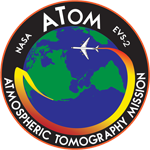The PolSIR instrument – short for Polarized Submillimeter Ice-cloud Radiometer – will help humanity better understand Earth’s dynamic atmosphere and its impact on climate by studying ice […]
The Investigation of Convective Updrafts (INCUS) mission will be a collection of three SmallSats, carrying RainCube-like radars with crosstrack scanning and a Tempest-D-like radiometer, flying in tight […]
NASA’s ACTIVATE mission is on the hunt for clouds off the coast over the western Atlantic Ocean! It is looking for answers to help us understand how […]
The CALIPSO satellite provides new insight into the role that clouds and atmospheric aerosols play in regulating Earth’s weather, climate, and air quality. Related
NASA launched the CloudSat and the Cloud-Aerosol Lidar and Infrared Pathfinder Satellite Observation (CALIPSO) spacecraft to study the role that clouds and aerosols play in regulating Earth’s […]
The Cyclone Global Navigation Satellite System (CYGNSS) will probe the inner core of hurricanes to learn about their rapid intensification. Related
During the summer, strong convective storms over North America overshoot the tropopause into the lower stratosphere. These storms carry water and pollutants from the troposphere into the […]
Deltas everywhere provide many benefits to life on earth – like serving as a natural protection for our cities and towns against storm surges and tsunamis, or […]
ECOSTRESS data can indicate when plants are stressed and that a drought is likely to occur providing the option for decision makers to take action. […]
The Earth Surface Mineral Dust Source Investigation (EMIT) is an Earth Ventures-Instrument (EVI-4) Mission to map the surface mineralogy of arid dust source regions via imaging spectroscopy […]
Data from NASA’s Global Ecosystem Dynamics Investigation (GEDI) mission are adding to our understanding of carbon cycling and the structure and development of global biomes. […]
GeoCarb’s mission is to study Earth’s carbon cycle: The exchange of carbon among land, ocean, plants and animals, via processes like respiration and photosynthesis from the biosphere […]
NASA has selected a space-based instrument under its Earth Venture Instrument (EVI) portfolio that will make observations of coastal waters to help protect ecosystem sustainability, improve resource […]
New NASA research project employs an impressive array of technology to discern how and why intense bands of snow form in winter storms in order to supply […]
NASA has selected a new space-based instrument as an innovative and cost-effective approach to maintaining the 40-year data record of the balance between the solar radiation entering […]
The Multi-Angle Imager for Aerosols (MAIA) represents the first time NASA has partnered with epidemiologists and health organizations to use space-based data to study human health and […]
The North Atlantic Aerosols and Marine Ecosystems Study (NAAMES) is a five year investigation to resolve key processes controlling ocean system function, their influences on atmospheric aerosols […]
The Orbiting Carbon Observatory-2 (OCO-2) model intercomparison project (MIP) is a collaboration among atmospheric CO2 modelers to study the impact of assimilating OCO-2 retrieval data into atmospheric […]
The Orbiting Carbon Observatory 3, or OCO-3, is a future space instrument designed to investigate important questions about the distribution of carbon dioxide on Earth as it […]
NASA’s Oceans Melting Greenland (OMG) mission is right here on Earth and it’s showing us the precise role oceans are playing in melting glaciers. Some glaciers in […]
PREFIRE will document, for the first time, variability in spectral fluxes from 5-45 μm on hourly to seasonal timescales. Two 6U CubeSats in distinct 470–650 km altitude, […]
The Sub-Mesoscale Ocean Dynamics Experiment (S-MODE) is a NASA Earth Venture Suborbital-3 (EVS-3) mission. S-MODE will use measurements from a novel combination of platforms and instruments, along […]
The TEMPO (Tropospheric Emissions: Monitoring Pollution) mission aims to answer this question with more detail and precision than ever before, by creating a revolutionary new dataset of […]
Tropical cyclones have been a source of some of the most devastating natural disasters, claiming countless lives, accounting for more than half of U.S. billion-dollar natural disaster […]

